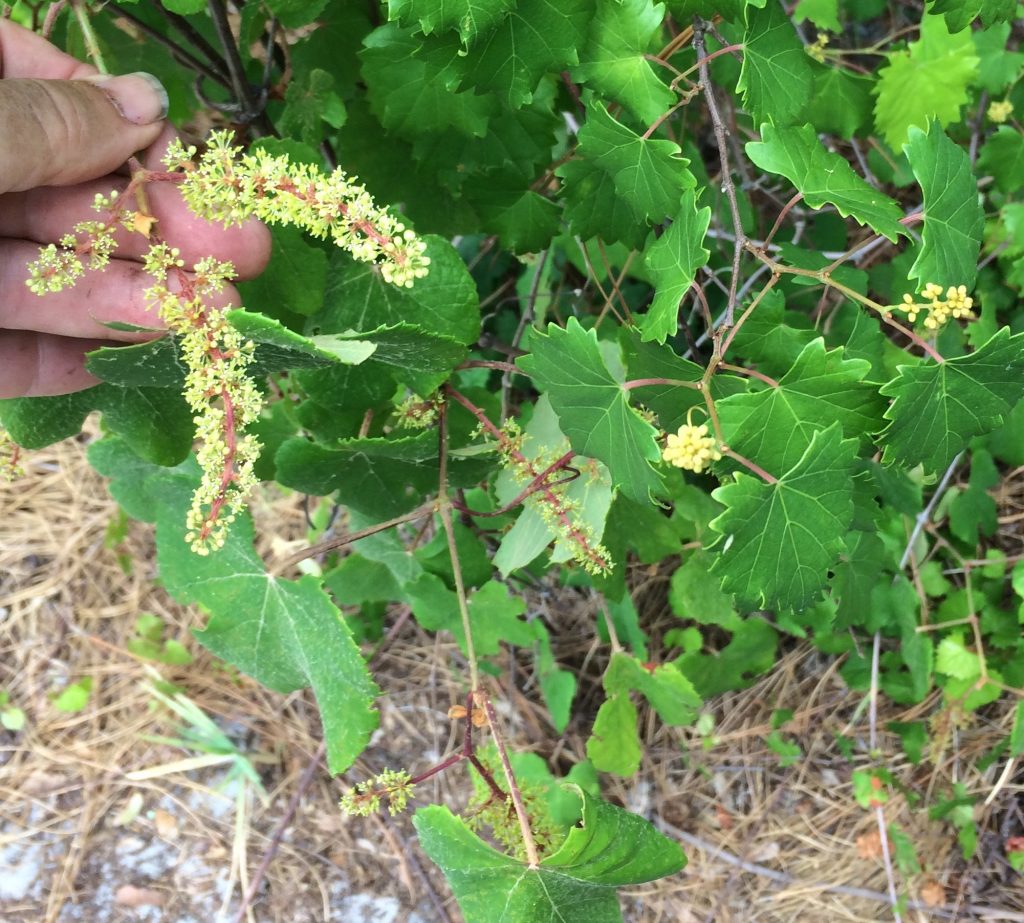
Two different species of grape fruiting next to each other. Photo by Green Deane
Not all of botany is settled. There are at least six species of grapes locally, Vitis aestivalis, V. cinera, V. palmata, V. rotundifolia, V. shuttleworthii and V. vulpina. Their status has been the topic of debate but as of late all six are currently considered native. One, V. rotundifolia, might be moved out of the grape genus. It’s closely related to Peppervine and Virginia Creeper and has 38 genes instead of the usual 40 for grapes. It could be cleaved into two species — V. munsoniana and V. popenoei — in the new genus of Muscadinia.
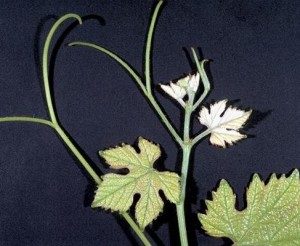
Forked-tendril species produce better grapes.
This weekend we got a chance to see two of them blossoming side by side. As you can see in the main picture above the grouping of the blossoms are different. On the left is, I think, V. aestivalis, The Summer Grape. It has forked tendrils and will annually produce a bunch of sweet grapes about half the size of those sold in grocery stores. The other is V. rotundifolia, simply called muscadine. It has a single tendril and fruits irregularly with clusters of grapes. They are often very acidic. The leaves and blossoms of the two species are different. The Summer Grape often has fuzzy leaves and a long spike of blossoms. The Muscadine leaves are hairless and the blossom a cluster. While one usually finds grapes ripening around early September they can be found from late July to early October. You can read about grapes here.
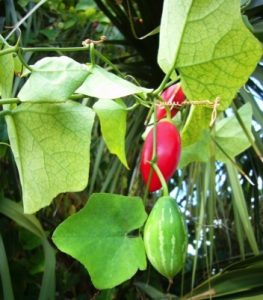
Ivy Gourd fruit ripens to red. Photo by Green Deane
If you have an established Ivy Gourd you know what this entry will be about: They are fruiting now and will do so until cold weather some seven months from now. The Ivy Gourd has a schizophrenic status. It’s an escaped Asian vegetable that grows well locally and is nearly pest free. It seems resistant to most virus and fungus but is attacked for about now for three weeks by some lava. I just cut them out and eat the rest. Because the Ivy Gourd is so prolific and resistant it’s popular with home gardeners and permaculturists. On the other side of the issue, as it is not native it is on the radar of the Native Plant Society and the state as an invasive. I personally don’t know how invasive it is because while it’s available but I don’t see it too often in my wanderings. I find it an excellent vegetable, either when green or ripe red. It will probably grow in popularity as more and more people start growing their own food. You can read about Ivy Gourd here.
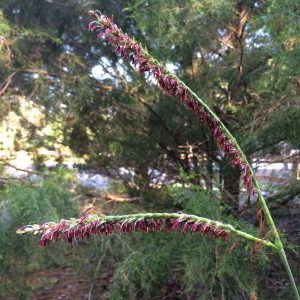
Eastern Gamagrass can be used like wheat. Photo by Green Deane
Grass and ice cream are usually not considered at the same time unless it is Eastern Gamagrass. Why? Because livestock like the clumping Tripsacinae so much cattlemen call in Ice Cream Grass. While it can be used like wheat it’s a distant relative of corn. Eastern Gamagrass is sod forming and can reach up to eight-feet tall. Though it is pollinating now locally the grass can seed from June to September. As you can tell from photo to the right the male flowers occupy the top three-fourths of the spike and the female flowers the bottom fourth. In this species the girls are brown, hair-like structures. Besides fodder Eastern Gamagrass is a common ornamental found in parks and residential areas. A bunch can live to be 50 years old or more To read more about Eastern Gamagrass go here.

Foraging classes are held rain, shine, hot or cold. Photo by Nermina Krenata
Foraging Classes: This week yours truly wended through highway rain to hold classes along the east coast. Also both classes in Jacksonville and Melbourne got to see the deadly Water Hemlock reaching maturity and blossoming. Knowing wild edible plants is important, knowing deadly wild plants is more important. This weekend one class in mid-state in Orlando and the other in the lovely area of Port Charlotte. As that class in on the brackish end of the Peace River we get to see some salt-tolerant edibles.
Saturday, May 12th, Blanchard Park, 10501 Jay Blanchard Trail, Orlando, FL 32817. 9 a.m. Meet at the pavilion east of the tennis courts near the YMCA.
Sunday, May 13th, Bayshore Live Oak Park, Bayshore Drive. Port Charlotte, FL, 9 a.m. Meet at the parking lot across from Ganyard Street.
Saturday May 19th, Eagle Park Lake, 1800 Keene Road, Largo, FL 33771. 9 a.m. Meet at the pavilion near the dog park.
Sunday May, 20th, a non-Green Deane event. Join the Orlando Mushroom Group for its spring fungal Forage a few miles west of Sanford, Fl. For more information go the the Orlando Mushroom Group page on Facebook or email GreenDeane@gmail.com.
Saturday, May 26th, George LeStrange Preserve, 4911 Ralls Road, Fort Pierce, FL, 34981. 9 a.m.
Sunday May 27th, Dreher Park, 1200 Southern Blvd., West Palm Beach, 33405. 9 a.m. just north of the science center.
Saturday, June 2nd, Red Bug Slough Preserve, 5200 Beneva Road, Sarasota, FL, 34233, 9 a.m.
Sunday June 3rd, Colby-Alderman Park: 1099 Massachusetts Street, Cassadaga. Fla. 9 a.m., meet near the restrooms.
Saturday, June 9th, Blanchard Park, 10501 Jay Blanchard Trail, Orlando, FL 32817. 9 a.m. Meet at the pavilion east of the tennis courts near the YMCA.
Sunday, June 10th, Boulware Springs Park, 3420 SE 15th St., Gainesville, FL 32641. Meet at the picnic tables next to the pump house, 9 a.m.
 All of Green Deane’s videos available for free on You Tube. They do have ads on them so every time you watch a Green Deane video I get a quarter of one cent. Four views, one cent. Not exactly a large money-maker but it helps pays for this newsletter. If you want to see the videos without ads and some in slightly better quality you can order the DVD set. It is nine DVDs with 15 videos on each. Many people want their own copy of the videos or they have a slow service and its easier to order then to watch them on-line. They make a good gift for that forager you know. Individual DVDs can also be ordered. You can order them by clicking on the button on the top right of this page or you can go here.
All of Green Deane’s videos available for free on You Tube. They do have ads on them so every time you watch a Green Deane video I get a quarter of one cent. Four views, one cent. Not exactly a large money-maker but it helps pays for this newsletter. If you want to see the videos without ads and some in slightly better quality you can order the DVD set. It is nine DVDs with 15 videos on each. Many people want their own copy of the videos or they have a slow service and its easier to order then to watch them on-line. They make a good gift for that forager you know. Individual DVDs can also be ordered. You can order them by clicking on the button on the top right of this page or you can go here.

Green Deane Forum
Want to identify a plant? Looking for a foraging reference? Do you have a UFO, an Unidentified Flowering Object you want identified? On the Green Deane Forum we chat about foraging all year. And it’s not just about warm-weather plants or just North American flora. Many nations around the world share common weeds so there’s a lot to talk about. There’s also more than weeds. The reference section has information for foraging around the world. There are also articles on food preservation, and forgotten skills from making bows to fermenting food. One special section is “From the Frightening Mail Bag” where we learn from people’s mistakes. You can join the forum by clicking on the button in the menu line.
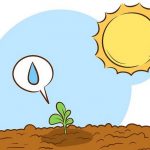 Donations to upgrade EatTheWeeds.com and fund a book are going well and past 50%. Thank you to all who have contributed to either via the Go Fund Me link, the PayPal donation link or by writing to Green Deane POB 941793 Maitland FL, 32794. The site has been up for a dozen years, has always been free, and went through a couple of difficult upgrades. The most recent upgrades have been paid for, again thank you. A new server also being considered with Host Gator being the temporary home. Trying to include more than a year’s worth of newsletter into a new category function is proving to be a programming headache. The other issue is finding an indexing program or function for a real book. Writing programs used to do it automatically if you designated a term for indexing. Now that most books are ebooks most writing programs do not provide and indexing function.
Donations to upgrade EatTheWeeds.com and fund a book are going well and past 50%. Thank you to all who have contributed to either via the Go Fund Me link, the PayPal donation link or by writing to Green Deane POB 941793 Maitland FL, 32794. The site has been up for a dozen years, has always been free, and went through a couple of difficult upgrades. The most recent upgrades have been paid for, again thank you. A new server also being considered with Host Gator being the temporary home. Trying to include more than a year’s worth of newsletter into a new category function is proving to be a programming headache. The other issue is finding an indexing program or function for a real book. Writing programs used to do it automatically if you designated a term for indexing. Now that most books are ebooks most writing programs do not provide and indexing function.
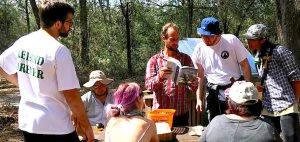
Orlando Mushroom Group
As you can tell by the schedule above the Orlando Mushroom Group will have its spring mushroom hunt with Joshua Buchanan May 20th at the Lower Wekiva River Preserve State Park. That is on State Road 46 (west of Sanford.) Because of road construction the exact place where we will meet will be announced but it should be within a quarter of a mile or so. Time: 9 a.m. Fee: $10 per adult. Rain or shine. Dress for bugs, walking and know rattle snakes are common in the area. Thus walking sticks are recommended. We will be finding and identifying various local mushrooms. The location has produce a wide array of both edible and non-edible mushrooms from chanterelles to Lactifluus to Boletes. You can RSVP here and or email GreenDeane@gmail.com.
This is weekly issue 303.
If you would like to donate to Eat The Weeds please click here.

